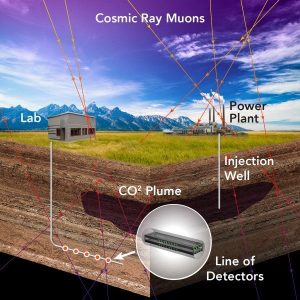
Credit: PNNL
Muons, once used to explore the inside of pyramids and volcanoes alike, are enabling researchers to see deep underground with a technological breakthrough from PNNL.
Invisible to the naked eye, muons are elementary particles created by the collisions of cosmic rays with molecules in the atmosphere. Muons are constantly raining down on the earth at various angles. They can pass through materials, such as earth and rock, and detecting these particles have helped researchers “see” the inside of structures such as the pyramids of Giza. But the detectors — which measure the number and trajectories of muons hitting the detector — are rather large, about the size of a small car.
In order to be able to “see” changes in density underground, the detectors need to be much smaller. PNNL researchers and their partners have created a smaller — just six inches in diameter and about three feet long — and more rugged version. This mini detector will be able to go thousands of feet underground via horizontal boreholes.
The borehole-sized detectors are made out of plastic components and optical fibers that carry signals to electronics to count each muon that passes through the device. This summer, researchers tested its output against two existing large detectors in a tunnel at Los Alamos National Laboratory. The results were the same as the larger machines developed by LANL and Sandia National Laboratories. Like its big brothers, the small detector can measure anomalies in the flux of muons that pass through. A change in the number of muons hitting the detector during a certain period and space indicate a change in density within the structure or object — for instance a plume or reservoir of carbon dioxide underground.
The data convert to an image and both could help monitor CO2 movement or leakage underground at a sequestration site, and have applications for a wide variety of subsurface imaging.
Alain Bonneville, a geophysicist at Pacific Northwest National Laboratory, will present details on the muon detector and the comparative field tests at the American Geophysical Union Fall Meeting in San Francisco.
Note: The above post is reprinted from materials provided by Pacific Northwest National Laboratory.










